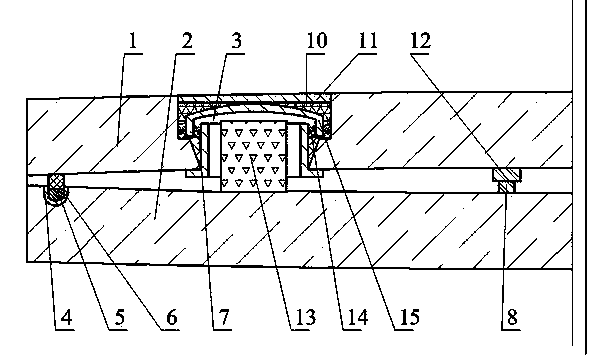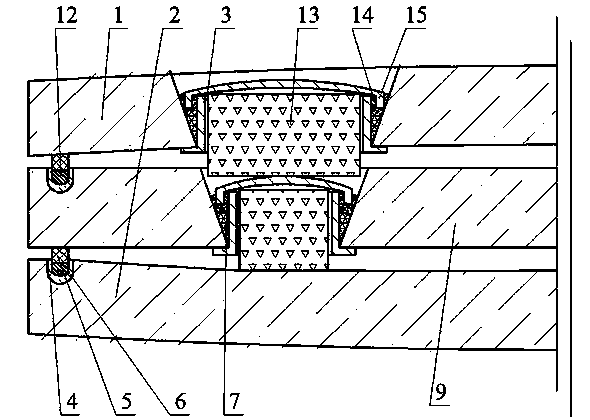Microwave-welded convex tempered vacuum glass edge-sealed with sealing groove and having getter
A technology of vacuum glass and microwave welding, which is applied in glass production, glass forming, glass reshaping, etc. It can solve the problems of complex encapsulation and placement of getters, impact on appearance, and small getter dose.
- Summary
- Abstract
- Description
- Claims
- Application Information
AI Technical Summary
Problems solved by technology
Method used
Image
Examples
Embodiment 1
[0074] Embodiment 1: see figure 1, the two pieces of tempered vacuum glass are tempered glass or semi-tempered glass, one of which is low-emissivity glass. Drill a tapered through hole at the corner of the glass 1 as the air outlet 3, set up a sealing groove 6 around the periphery of the lower glass 2, and perform edge grinding, chamfering, cleaning and drying, and use tempered glass at the peripheral welding of the upper glass 1 The ink is prepared by mechanical spraying technology to prepare the sealing strip 5; secondly, put two pieces of glass into two forming molds respectively, put the forming mold with glass in the tempering furnace, heat up to the temperature at which the glass softens, and rely on gravity to make the forming mold The glass forms a convex surface downwards, and then it is air-cooled and tempered to obtain tempered or semi-tempered glass; the support is made of a high polymer alone, and the high polymer is polyimide. First, pyromellitic dianhydride and ...
Embodiment 2
[0075] Example 2: see figure 2 , the upper and lower glass of the double vacuum layer tempered vacuum glass is tempered glass or semi-tempered glass, and the middle glass is low-emissivity glass. The production method is as follows: First, cut three planes of the required size according to the shape and size of the vacuum glass to be produced. Glass, on upper glass 1 and middle glass 9, drill a conical through hole respectively to form air extraction port 3, wherein the through hole on the upper glass 1 is greater than the through hole on the middle glass 9, respectively make the metal circle of lower end flanging The pipe is inserted into the air outlet, the outer sides of the lower part of the round pipe are closely matched with the lower end of the air outlet 3, the upper part of the round pipe and the air outlet form a sealing groove 14, and the top of the round pipe is lower than the top of the upper glass 1 and the middle glass 9 respectively. surface; respectively make...
PUM
 Login to View More
Login to View More Abstract
Description
Claims
Application Information
 Login to View More
Login to View More - R&D
- Intellectual Property
- Life Sciences
- Materials
- Tech Scout
- Unparalleled Data Quality
- Higher Quality Content
- 60% Fewer Hallucinations
Browse by: Latest US Patents, China's latest patents, Technical Efficacy Thesaurus, Application Domain, Technology Topic, Popular Technical Reports.
© 2025 PatSnap. All rights reserved.Legal|Privacy policy|Modern Slavery Act Transparency Statement|Sitemap|About US| Contact US: help@patsnap.com


